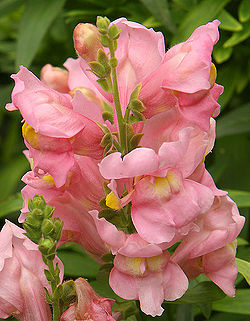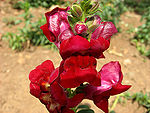Snapdragon
| Snapdragon |
|---|

|
| Scientific Classification |
|
| Species |
|
Snapdragons are a number of species of ornamental flowering plants that belong to the taxonomic genus Antirrhinum. They are mostly found in the Mediterranean region, but Old World and New World species are identified. [2]
There are three genes that control the coloration in the snapdragons: ROSEA, ELUTA, and SULFUREA. ROSEA and ELUTA control the brightness and pattern of anthocyanin, the magenta pigment. SULFUREA controls how the yellow aurone pigment is distributed. [3] By pressing the blossom of the snapdragon between your thumb and finger, you can make it open like a dragon's mouth; this is how the term "snapdragon" was coined. [4]
Anatomy
The snapdragon has a large, flowered head that is fragrant and diversely colored. The vertical "spike-shaped" flowers open from the bottom and are widest at the top. The dwarf snapdragon can grow to be around ten inches tall and the average snapdragon can be around eighteen to twenty-four inches tall. [5] The body of the snapdragon is made up of eleven parts: Upper lip, stigma, anthers, filaments, style, sepal, staminodium, ovary, bract, gibba, and the bump. [6] By pressing the blossom between your thumb and finger, you can make it open like a dragon's mouth; this coined the term "snapdragon" [7]
Ecology
Snapdragons have been put into two categories: Old World and New World species. There is about twenty Old World species in the category "Antirrhinum majus". Most of them grow in the western part of the Mediterranean region. They are mainly on the Iberian Peninsula. There are two to six species in the section Orontium. It includes the Lesser snapdragon and it is also located near the Mediterranean. They are often put in the genus "Misopates." The third section is Saerorhinum. It has sixteen New World species. It is mostly made up of annuals. Snapdragons are also used in botanical research. [8]
Reproduction
Snapdragons are "annuals". This means that they bloom only once a year. [9] grow from very small seeds. It generally takes about three weeks for the seeds to germinate. It is advised to plant them around six weeks before the last frost. [10] The snapdragons in yellow and magenta are reproduced most often. There are three genes that control the coloration in the snapdragons: ROSEA, ELUTA, and SULFUREA. ROSEA and ELUTA control the brightness and pattern of anthocyanin, the magenta pigment. SULFUREA controls how the yellow aurone pigment is distributed. [11]
Gardening Basics
Snapdragons come in colors of: white, yellow, burgundy, red, pink, and a brownish-bronze color. Plant them in "well drained", rich soil that has a lot of "organic matter." Snapdragons grow best in full sunlight. If you are planting the tall snapdragons, plant them about twelve inches apart. For the smaller type, plant about six inches apart. If you pinch the tips of the young plants, they will be more likely to branch off. Germination takes about eight full days of seventy degree Fahrenheit weather. If you want the snapdragons to bloom early, plant the seeds indoors six to eight weeks before the outdoor planting season. [12]


